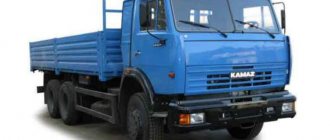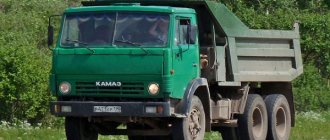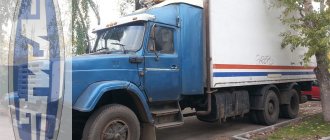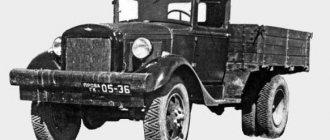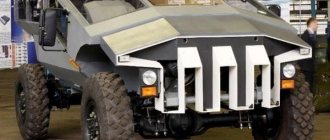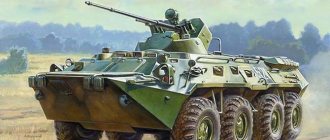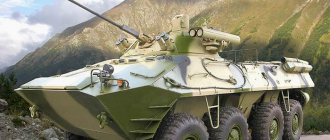The KamAZ car is one of the flagships of the socialist industry, giving Soviet citizens and Russians a sense of pride. Its appearance is directly related to the rapid growth of industrial production, better known as the Kosygin reform.
It’s hard to believe, but the American automotive culture took a direct part in the creation of the people’s car of the USSR - the KamAZ 5320. How it happened and why such a successful model was produced for less than 20 years is described in this article.
History of creation
After L.N. came to power. Brezhnev, a wave of economic development began in the country. Accordingly, the volume of cargo transportation has increased. The question arose about increasing the body on trucks, which could be achieved through a cabover cab design.
It is worth noting that there were no serial cabovers in the Soviet automotive industry at that time. The MAZ-500 had been in development for several years and the start date for production was unknown.
Once again, domestic developers had to pay attention to the Western fleet of trucks.
For the sample, several production models of the cabover type were purchased in the USA.
The chief designer of the ZIL automobile enterprise, Anatoly Mavrikievich Krieger, chose the American “International” truck of the 220 series. Soviet engineers decided to take the project to a higher level thanks to innovative solutions, including:
- driver comfort;
- increased visibility;
- easy controls;
- economical fuel consumption;
- reliable transmission.
In 1967, the KEO automobile plant team began developing a prototype model, which would later be assigned the ZIL-170 index. As a basis, we took the design of the ZIL-133 diesel chassis, the serial production of which was postponed.
The terms of reference envisaged the production of ten cargo modifications of highway vehicles with a 4X2/6X4 wheel arrangement for operation in a group of road trains with a permissible maximum weight of up to 26,500 kg. It was also necessary to create six 6X6 vehicles with permanent drive for the needs of the army and difficult terrain.
A prototype of a promising truck was created in 1968. The prototype was equipped with a diesel engine from a Yaroslavl plant (YaMZ). The ZIL-170's baptism of fire took place on the highway from Uglich to Rybinsk in May 1969. The vehicle was also tested on the serpentine roads of the Caucasus Mountains, where the transmission took on maximum loads.
The sudden resolution of the Central Committee of the USSR Party on the construction of factories for the production of trucks in the Tatar Autonomous Soviet Socialist Republic, Naberezhnye Chelny, upset Moscow automakers.
The ZiL team spent several years perfecting the car and did not want to part with their brainchild. But the party’s order was not disputed and further work with the prototype was transferred to new workshops of the Tatar Republic.
According to the state plan, the built automobile plant was supposed to annually produce 150,000 units of equipment and 250,000 engines. The name of the truck was changed to KamAZ. The first prototype of the Kama plant equipment was released in 1974.
Serial models delighted Soviet society with their birth on February 16, 1976. This happened on the eve of the 25th Congress of the CPSU, which opened on February 24. The cabs of the new KamAZ trucks were decorated with workers’ slogans “Our gift to the XXV Congress of the CPSU.”
According to the production plan, from 1976 to 1978, the company produced only three modifications of the serial KamAZ-5320:
- onboard platform with a lifting capacity of 8 tons;
- construction dump truck 10 t;
- truck tractor with a permissible weight of 26.5 tons.
Among the total volume of equipment produced, 43% were dump trucks, followed by on-board platforms 27% and the remaining 20% related to the production of truck tractors with a new ten-speed gearbox.
In 1981, KamAZ launched the second stage of production facilities, which began producing the 6-ton 4310 vehicle with a 6X6 wheel arrangement and single-pitch tires.
The military version of the 4310 was equipped with a winch, a pneumatic tire pressure control system and two fuel tanks. The agricultural version 43105 was simplified and weighed 7 tons.
Only by the mid-80s did the car plant in Naberezhnye Chelny enter a stable production cycle. The high pace allowed the millionth truck to be produced by October 1988. The expected demand for a domestic truck from international customers did not materialize. This situation allowed KamAZ to take a strong position only in the domestic market.
Another sad moment for the truck was the period of perestroika. Imported trucks began to arrive in the USSR, which were crowding out the car in their own country. KamAZ could not compete with them, which forced the plant to begin developing a new generation of vehicles, the production of which began in the 90s.
Update
Some time after the release of the KamAZ-5320, engineers at the Kama Automobile Plant developed other trucks based on it:
- Truck tractor 5410 , which is capable of transporting a semi-trailer with a load capacity of 13.5 thousand kg. The weight of the loaded trailer is 19,000 kg.
- Dump truck 5511 – can withstand up to 10 tons. The machine is equipped with a metal bucket-shaped platform, there is no tailgate. Loaded with construction materials and industrial cargo.
- Tractor 53112. Can transport up to 10,000 kg, has an enlarged wheel arrangement and a large platform. The trailer weight for this model has increased to 20 tons.
- KamAZ-55102 is a dump truck for working with a trailer (mainly GKB 9527).
Design
The layout of the KamAZ-5320 vehicle corresponded to the classic cabover design of trucks of that time. The cabin had three seats and tilted forward using a torsion bar, providing access to the engine. The power plant and gearbox are attached to the frame using shock-absorbing supports, thereby forming a single chassis complex.
Frame
The KamAZ-5320 frame is a load-bearing spar type with riveted joints. It consists of two parallel beams-spars connected to each other by seven transverse beams.
Carbon steel is used as the material for manufacturing the structural components.
The front parts of the load-bearing side members have a beveled structure for mounting the suspension. Towing hooks are also attached to them. The front buffer is mounted to the supporting beams using bolts.
Engine
The truck was equipped with V-shaped four-stroke diesel engines. The production of power plants was carried out by the Yaroslavl Motor Plant. The unit had a power of 210 and 180 hp at a maximum of 2600 rpm.
At that time, this type of engine was considered advanced, since its design used new technologies, including a nitrided crankshaft and full-flow oil purification in a centrifugal filter. The cooling system was equipped with a fluid coupling, which turned on automatically, regulating the operating temperature of the fluid.
Transmission
The KamAZ-5320 gearbox has a double-disc clutch. The clutch drive is controlled using hydraulics with pneumatic booster, which greatly facilitates the use of the pedal. A special feature of the gearbox is a divider (multiplier), which is an additional gearbox in front of the main gearbox.
Thus, five overdrive gears are added to the five direct gears.
Gear shifting occurs remotely using a rocker. The connection between the gearbox and the main drive units (axle) is carried out using cardan shafts and joints with needle bearings (crosspieces). The middle axle is equipped with a center differential.
Brake system
The KamAZ-5320 device uses a dual-circuit brake system for the front axle and rear bogie. It is divided into three subsystems: main, parking and spare. All wheels are equipped with brake drums. Each of them contains a pair of pads.
The brakes are powered by compressed air pumped by the compressor. The air is accumulated in receivers. When parking, the car is set to the parking brake, which operates using energy accumulators. They are located on the axles of the rear bogie.
Steering
The steering mechanism consists of: a steering wheel, a steering column, a driveshaft, a steering mechanism with a piston-rack, a bipod, steering rods and a hydraulic booster. The latter makes it easier for the driver to rotate the steering wheel, making control comfortable.
Suspension
The front suspension consists of springs and double-acting hydraulic shock absorbers. The rear suspension is of the balancing type. Rear spring leaves with sliding front and rear ends with T-profile.
Device
Appearance
Due to the large number of vehicles produced by the Russian concern, the appearance of the truck is recognizable on the roads. Despite the fact that the external data is outdated, model 5320 is considered a symbol of the KamAZ plant.
Cabin interior
Soviet engineers managed to develop a cabin that seems quite comfortable even for modern conditions. The salon is designed for three people; a sleeping place has not yet been provided, since the car did not operate around the clock.
The interior boasts insulation and the cabin is cold-proof. The designers provided seat belts and a spring-type driver's seat, which is adjustable to his height. Connoisseurs of Soviet trucks note the presence of visual instruments, indicators and scales in the cabin, which provide the driver with maximum information and make his journey safe. These include a pressure gauge with two arrows, a switch that regulates the position of the platform, and a speed sensor.
Among the shortcomings, the steering wheel is too large and the pedals are quite stiff.
Frame
The design of the truck includes a spar-type frame, consisting of two beams, which, in turn, are connected by additional beams. The beams are made of carbon steel, which has a large margin of safety. The front parts of the beams are designed in the form of a cone for mounting the suspension. The Kamaz frame number is indicated on the right side member.
Use of KamAZ in army units
From the moment they entered production, KamAZ trucks also entered the formations of the USSR Armed Forces.
These vehicles received their baptism of fire at OKSVA during combat operations in Afghanistan, where they gained the reputation of being reliable and powerful vehicles, including when used in the highlands.
The main differences between the army modification of KamAZ and the civilian line were: reinforced design, a reshaped bumper, and the mandatory presence of a tire pressure regulation system. There were other differences, not so significant. The scope of use of machines in the army was quite wide:
- a vehicle for transporting bulk cargo and personnel;
- use as a platform for installing various radio equipment: command and control vehicles, launch control command posts and mobile stations for performing other tasks;
- armored vehicles for transporting personnel in the theater of military operations, this type of vehicle was not mass-produced, the armor was attached to the base model;
- vehicles for escorting convoys, gun trucks with ZU-23-3 weapons.
It’s worth talking about “gun trucks” in a little more detail; these vehicles initially had as their task the escort of convoys as they were escorted through the mountains of Afghanistan. A ZPU-4 or ZU-23-2 anti-aircraft gun was installed in the back of the vehicle.
These installations had the ability to fire all around, had an anti-aircraft elevation angle and powerful cartridges; their shells and bullets could reach the enemy at long range and altitude. This made it possible to effectively combat ambushes on the road.
The armoring of such vehicles was often makeshift and consisted of hanging the cabin doors with bulletproof vests, less often they were sheathed with metal.
The charger installation itself was covered with doors from the infantry fighting vehicle or other improvised means, the purpose of which was to protect the installation crew, although it was minimal. Subsequently, the production of such support products was suspended.
The armored Urals and KamAZs, which appeared during the Caucasian Wars and were nicknamed “Pokemons,” are also a product of handicraft production; there are practically no such vehicles in the series. Although their high efficiency in operation has been proven.
What is the price
Today, a KAMAZ 5320 “with mileage” can be purchased for literally anywhere from 1,500 to 300,000 rubles (basic model); a KAMAZ-5410 truck tractor, a 53121 dump truck (another KAMAZ-dump truck - 6520 and a KamAZ 55111) on a KAMAZ 5320 chassis can cost a little more. and other models mentioned in this article - they are offered on the secondary market at a price of 200,000 rubles .
For hilly and mountainous terrain, it is recommended to choose KamAZ 65115 and 65116 series. They have an additional secondary shaft gear (see KamAZ mountain brake) which allows engine braking to be more effective.
Well, the history of the Paris-Dakar rally, where KAMAZ trucks always take by no means the last places, is far from over. A model created specifically for racing is here.
Specifications
KamAZ had and remains its main competitor in the domestic market - the MAZ car. It is worth noting that the first developments of the ZIL-170 were carried out with the participation of specialists from the Minsk Automobile Plant. Each of the trucks has its own advantages and disadvantages, but there are still a sufficient number of admirers of both cars.
Here are the main technical characteristics for comparison:
| KamAZ - 5320 | MAZ-5335 | |
| Length, mm | 8395 | 7250 |
| Width, mm | 2500 | 2500 |
| Height, mm | 2830 | 2720 |
| Vehicle weight, kg | 7080 | 6725 |
| Load capacity, kg | 8000 | 8225 |
| Maximum speed, km/h | 80-85 | 80-85 |
| Fuel consumption, l/100 km | 23-29 | 22-24 |
| Engine power, l. With. | 210 (KAMAZ-740.10) | 180 (YaMZ-236) |
| Fuel capacity, l | 170 | 200 |
| Cabin type | No sleeping place | There is a sleeping place |
| Tires | 260 R 508 | 300 R 508 |
Advantages and disadvantages
Over the quarter century of its operation, KamAZ-5320 has completed a lot of tasks, transported a huge amount of cargo, and to this day is considered a representative of special equipment with successfully developed technical characteristics. It is not surprising that during the work, drivers noted both positive and negative aspects of the tractor produced in the Kama region.
Pros of the car
The advantages of the machine concern all aspects of its operation:
- maintainability with the ability to find spare parts in service stores;
- low cost of the machine, which can be used for a long period of time;
- gearbox design, brake system quality;
- a practical car equipped with a comfortable cabin with good visibility;
- availability of modifications, trucks can operate in various production areas and in different weather conditions.
The advantages of this model include its durability, since it is difficult to find a manufacturer of special equipment whose car has been successful for a quarter of a century.
Cons of the car
Compared to new products in the truck transport industry, the KamAZ-5320 has some disadvantages that were noted back in the era of the beginning of the development of truck production:
- Quite noisy engine with insufficient cabin sound insulation;
- requires a lot of fuel: high consumption, despite engine modifications;
- there are not enough amenities in the car and the free space is filled irrationally;
- low quality of materials used for the manufacture of interior and upholstery.


